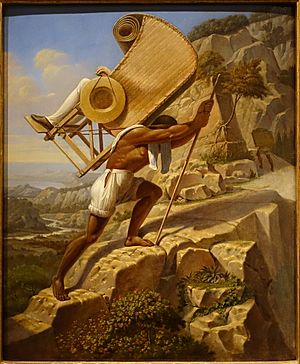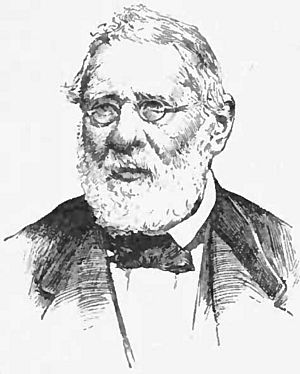Jean-Frédéric Waldeck facts for kids
Jean-Frédéric Waldeck (born March 16, 1766 – died April 30, 1875) was a French artist, mapmaker, and explorer. He was very talented, but he also loved to make himself sound more important. This means some parts of his life are a bit of a mystery!
Waldeck often changed his story about where he was born or what country he was from. He also sometimes claimed to be a count, duke, or baron, but there's no proof of these titles.
He said he traveled to South Africa when he was 19 and then became an explorer. He also claimed to have studied art in France and even gone to Egypt with Napoleon. However, there's no proof that these early stories are true. Most of what Waldeck said about his life before 1820 is not recorded anywhere else.
Waldeck is mainly remembered for two things. One is his exploration of Mexico. The other is his many drawings of ancient Maya and Aztec sculptures. Sadly, some mistakes in his drawings led to wrong ideas about these ancient civilizations.
He was active right up until he died. He claimed to be 109 years old when he passed away. People say he had a heart attack while looking at a beautiful woman in Paris.
Waldeck's Art of Ancient Mexico

Waldeck first saw art from ancient Mesoamerica when he was hired by a publisher named Henry Berthoud. This was in 1822. His job was to create drawings for a book called Description of the Ruins of an Ancient City. This book was an English translation of an old report about the ruins of Palenque in Mexico.
Waldeck's drawings were quite different from the original ones he copied. He made the ancient monuments look a lot like Egyptian buildings. This was because his boss believed that the ancient Mesoamericans were connected to the Lost Tribes of Israel.
In 1825, Waldeck got a job as a water engineer for a British mining company in Mexico. He didn't stay in this job for long. After that, he explored the ancient ruins of the country. He even lived in the ruined city of Palenque from May 1832 to July 1833.
Later, in 1834, Lord Kingsborough hired him. Waldeck was asked to travel to Uxmal and make drawings and rebuildings of the ancient structures. Some of these drawings were very imaginative and not always accurate.
In 1838, Waldeck published a book called Voyage pittoresque et archéologique dans la province d'Yucatan in Paris. This book showed his drawings of Mérida, Yucatán and Maya ruins, including those at Uxmal. Waldeck dedicated this book to Lord Kingsborough. He believed his drawings showed more links between the ancient Maya and ancient Egypt. For example, his drawing of the Pyramid of the Magician at Uxmal made it look like an Egyptian pyramid. In 1839, he became a member of the American Antiquarian Society.
Waldeck's drawings of Palenque were also used in a book by Charles Étienne Brasseur de Bourbourg in 1866. This book was called Monuments anciens du Mexique (Palenque, et autres ruines de l'ancienne civilisation du Mexique). Just like his earlier drawings, these new ones made the ancient Maya look like they were connected to ancient Greece and Rome.
His drawings of the Maya script panels in the Temple of Inscriptions at Palenque even showed clear pictures of elephant heads. This was a mistake and not actually there. This led people to guess about connections between the ancient Maya and Asia. It also fueled ideas about a mythical lost continent called Atlantis that supposedly linked old civilizations.
Waldeck created many lithographs (a type of print) of what he found. His last set of prints was published in 1866. This was when he celebrated his 100th birthday.
See also
 In Spanish: Jean-Frédéric Waldeck para niños
In Spanish: Jean-Frédéric Waldeck para niños


